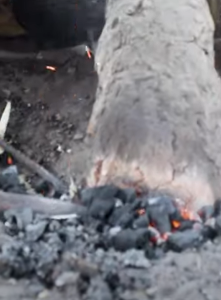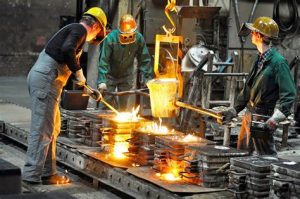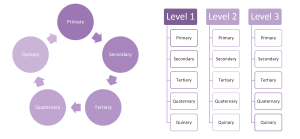Regressing to Progress
A CASE FOR SHIFTING THE MEAN ALONG THE ECONOMIC SECTOR CONTINUUM

During economic crises, nations often prioritise advanced sectors such as services and technology. However, this article argues that strategically regressing to reinforce lower economic sectors—such as agriculture and mining, and how they transition along the Economic Sector Continuum (as discussed below) like in manufacturing—can provide a stronger foundation for long-term growth. By strengthening these core sectors and how they transition, countries like Nigeria can stabilise their economies and create a platform for future progression in higher-value industries like services, innovation, and decision-making.
UNDERSTANDING THE FIVE SECTORS OF THE ECONOMY
Economies are classified into five distinct sectors, each moving further away from the direct use of natural resources:
1. Primary Sector: Involves the extraction of raw materials like agriculture, mining, and fishing. Most early-stage economies heavily depend on this sector.
2. Secondary Sector: Focuses on processing raw materials into finished products, encompassing manufacturing and construction, vital for industrial growth.
3. Tertiary Sector: The service industry, involving sectors like healthcare, retail, and education, which provide direct services to the population.
4. Quaternary Sector: Centres on intellectual services like research, technology, and education. Often called the knowledge economy, this sector is crucial for innovation.
5. Quinary Sector: Includes top-level decision-makers in government, healthcare, and education. This sector represents the highest level of economic activity.
As Matt Rosenberg explains in his article, The 5 Sectors of the Economy, these sectors form a continuum, with economic growth often depending on the strength of foundational sectors like primary and secondary (Rosenberg, 2024).
NIGERIA’S INDUSTRIAL DECLINE: A CASE STUDY
Nigeria, once rich in industrial potential, has experienced a decline in its industrial base over the years. The sale of the Nigerian Shipbuilding and Dockyard Industry (NSD) and the long-delayed construction of the Lagos-Ibadan Expressway are prime examples of the country’s weakened industrial capacity. This deterioration is largely due to poor governance, underinvestment, and inconsistent policies. One of the clearest indicators of this regression is the Ajaokuta Steel Complex, which has failed to fulfil its potential, further limiting Nigeria’s ability to industrialise.

Steel and the knowledge of how it can be used is the backbone of industrialisation and therefore it is essential for infrastructure development. This includes factories, bridges, and machinery. In many successful economies, such as South Korea and China, steel production played a key role in driving industrial growth. Unfortunately, Nigeria’s decline in metalworking expertise has severely affected industries reliant on this vital skill, such as construction, shipbuilding, and manufacturing, slowing the nation’s economic growth.
THE IMPORTANCE OF METALWORKING IN REBUILDING NIGERIA’S ECONOMY
A critical aspect of rebuilding Nigeria’s economy is the development of metalworking skills. Skilled metalworkers are indispensable in sectors such as construction, automotive manufacturing, and shipbuilding. However, the decline in technical skills has hampered Nigeria’s ability to produce the necessary materials for its industrial growth, leading to greater reliance on imports.

By investing in the training of metalworkers, Nigeria can increase industrial productivity, reduce dependence on foreign products, and create jobs. Furthermore, a strengthened metalworking sector would lay the groundwork for the development of the tertiary (service), quaternary (knowledge), and quinary (decision-making) sectors.
REGRESSING TO PROGRESS: STRENGTHENING FOUNDATIONAL SECTORS
The concept of “regressing to progress” centres on the idea that reinforcing the primary and secondary sectors during economic downturns can lead to stronger foundations for long-term growth. For Nigeria, this means focusing on sectors such as agriculture, iron mining, and manufacturing, which form the bedrock of its economy.
By revitalising the primary sector and how it transitions to the secondary sector, particularly in iron / steel and agriculture, Nigeria can reduce its reliance on oil exports and stabilise its economy while at the same time it strengthens the secondary sector (especially steel production and manufacturing) thereby providing the infrastructure necessary for future growth.
A robust secondary sector supports the tertiary sector, which includes services such as retail, healthcare, and tourism and it is in this sector, Nigeria excels. Infrastructure improvements help facilitate growth in the quaternary sector, promoting research, education, and technological innovation. Eventually, a more stable quinary sector, which involves high-level decision-making and governance, would emerge, further solidifying Nigeria’s position in the global economy. At its optimum, the Economic Sectors should be arranged in a way that is NOT hierarchical but spirally cyclical as modelled below.

The models above show how each economic sector should be seen as a cycle that creates layers of cycles. Each cycle creates the foundation for a next cycle to layer itself over the previous. It is strongly suggested that Nigeria should strip back to layer 1 cycle 1.
INVESTING IN METALWORKING SKILLS
Metalworking plays a pivotal role in infrastructure development. Industries such as automotive production, shipbuilding, and construction all depend on skilled metalworkers. However, the shortage of these skills in Nigeria has caused delays in critical projects, such as the Lagos-Ibadan Expressway, and undermined the country’s ability to maintain and build necessary infrastructure.
By investing in metalworking training, Nigeria can unlock its industrial potential and increase productivity in the secondary sector. A revived manufacturing base would support growth in the tertiary and quaternary sectors, ultimately creating a more balanced and diversified economy capable of handling future crises.
CONCLUSION: REGRESSING FOR SUSTAINABLE GROWTH
In summary, the strategy of regressing to progress offers a viable solution for nations like Nigeria to rebuild their economies. By focusing on the primary and secondary sectors, and making targeted investments in critical industries such as steel production and metalworking, Nigeria can create a foundation for sustainable growth in more advanced sectors of the economy.
As Matt Rosenberg’s article on the five sectors of the economy outlines, economic development is a continuous process where a strong primary and secondary sector supports the growth of higher sectors (Rosenberg, 2024). however it is argued in this article that the economic sectors should be a cycle of growth and that each completed cycle is a layer for the next. It is also argued that by regressing strategically, Nigeria can ensure its industrial base is robust enough to sustain future development and create long-term prosperity
REFERENCES
Rosenberg, Matt. (2024, September 3). The 5 Sectors of the Economy. Retrieved from [https://www.thoughtco.com/sectors-of-the-economy-1435795](https://www.thoughtco.com/sectors-of-the-economy-1435795).


